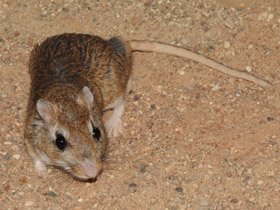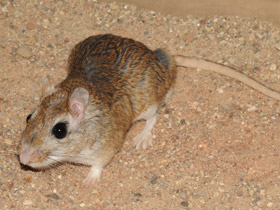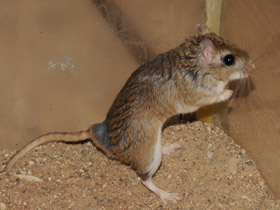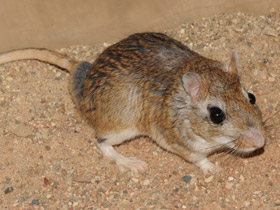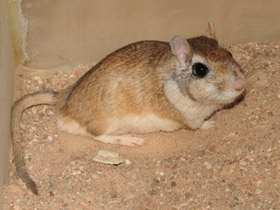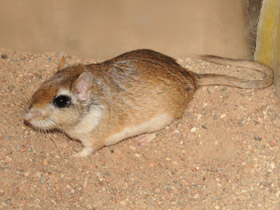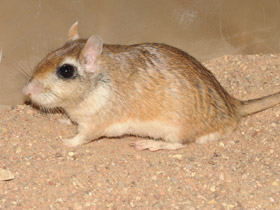The tamarisk jird or tamarisk gerbil (Meriones tamariscinus)
Description
The tamarisk jird or tamarisk gerbil (Meriones tamariscinus) is a species of rodent in the family Muridae.
The size of Meriones tamariscinus is relatively large: its body length reaches 180 mm. Its tail is shorter than the body length and is about 85% of its length without a panicle of elongated hairs. The sharply bicoloured tail of this gerbil is covered with short hairs along its entire length, which are elongated only at the end and form a small tassel. The soles of the feet of Meriones tamariscinus are entirely covered with hairs, whitish on the sides and front, and in the middle of the sole forming a distinct dark brownish spot in the form of a band or triangle.
Habitat
Meriones tamariscinus is distributed in northeastern Precaucasia, the Lower Volga region, Volga-Ural sands, southern Kazakhstan and Uzbekistan. In semi-deserts of north-eastern Predcaucasia (between Kuma and Terek) it is distributed westwards to Achikulak, Grozny Oblast; further it is found in semi-deserts of north-western Pre-Caspian and Lower Volga northwards to Cherniy Yar; between Volga and Urals its northern border is approximately 49°N (Jambay-tin). N (Dzhambey-Tinsky District, West Kazakhstan Oblast); further eastwards the northern boundary passes south of Irgiz, through the lower reaches of the Sary-Su River, the northern parts of the Muyun-Kumit Desert, the south-eastern coast of Balkhash, and reaches Lake Ala-Kul and Zaisan. To the south it is distributed in Ust-Urt, along the valley of the lower Amu Darya from the delta up to Chardzhou, in the area of Kizil-Kum and further south to Termez. Inhabits Bukhara and Samarkand oases. Absent in Tajikistan and Turkmenistan. Widespread in Xinjiang. Remains of this species or a closely related form of Pleistocene and Holocene age are known from the area of the lower Ural River. Semi-fossilised remains are also known from the eastern part of the Fergana Valley.
Lifestyle and habits
Meriones tamariscinus inhabits rather diverse habitats. In the north-west of its range (Volga-Ural semi-deserts) it is usually found in hilly sands, on compacted sandy soils in low relief parts. In sands, bushes of shrubs such as dzhuzgun, saltwort, spikenard, etc. are especially attractive for gerbils. Meriones tamariscinus also settle here in saline lowlands with clay soil overgrown with saltwort. In the Ural valley they are often found in small willow thickets near the river bank, and in Central Asia in coastal shrub thickets along river valleys and also on irrigated cultivated lands.
Meriones tamariscinus emerge from their dens at night, even in winter when frost is severe and snow cover is present. Their dwelling burrows are 6-8 cm in diameter and 4-5 m long and have numerous chambers. There is also a nesting chamber up to 20 cm in diameter at a depth of 50-80 cm. Winter burrows are much deeper (200-250 cm), but there are no chambers with winter stores in them.
What they feed on
Meriones tamariscinus feeds on seeds of various herbaceous plants and shrubs, but also eats green parts and roots in large quantities. According to observations in the Volga-Ural sands, in spring it feeds on leaves and underground parts of cuica stems and ephemerals; after ripening of cuica seeds it switches mainly to this food. From the second half Meriones tamariscinus eats fruits of shrubs and twigs of saltbush, in autumn - fruits of wormwood and other plants.
Reproduction
In the Volga-Ural sands, the reproduction period of Meriones tamariscinus lasts from April to October; pregnancy lasts about 20 days; a small number of females bring a second litter in summer; each brood usually contains 4-5 calves.

















